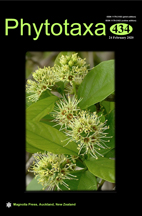Abstract
Recent botanical explorations in Sierra Madre Occidental in Durango, Mexico, led to the discovery of a new species which according to its morphology belongs to Salvia sect. Brandegeia. The new taxon is morphologically most similar to S. oresbia from central Mexico, against which it is thoroughly compared. Additionally, it is presented a synopsis of the section in order to provide updated and standardized descriptions for those species known only in base to their protologues, which allows a more detailed and precise comparison in respect to the new species. The morphological examination of the species in the section also revealed that the recognition of S. sharpii as a distinct species from S. blepharophylla is not justified; consequently, it is reduced to synonymy. An identification key, a distribution map, photographs, and a drawing of the new species are also presented.

